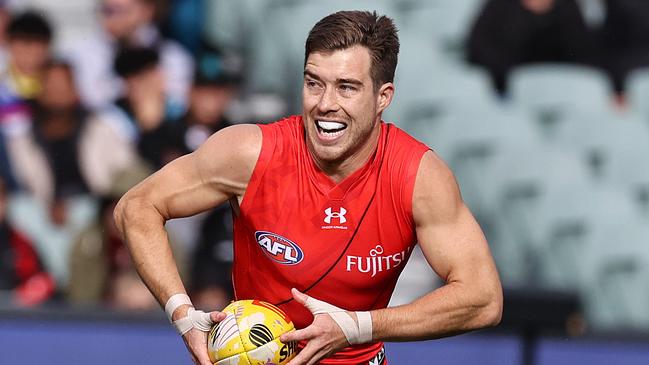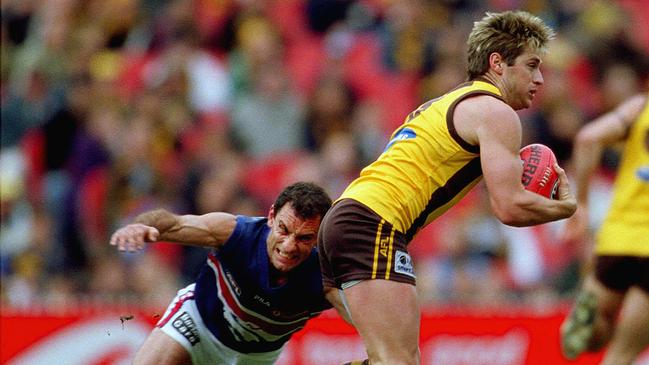Mick Malthouse says game is in strife after AFL’s dangerous tackle crackdown
The AFL season is in full swing, but there’s been plenty of controversy surrounding a number of suspensions. Here’s why Mick Malthouse thinks the game is in danger.

AFL
Don't miss out on the headlines from AFL. Followed categories will be added to My News.
Regardless of what era it is, the expectation of players who run down the race for every game is the same: win the ball.
With 36 players on the ground, either you win the ball or your opponent does, in which case you must limit their ability to use it.
It is that split-second moment that is causing great angst in the football community.
If the ball is loose, then to aid you in getting to the ball first you may have to bump your opponent. If your opponent gets to it first, you will have to tackle them. If the ball is in the air from a kick and you are in a non-marking position, you have to spoil.
It’s pretty simple.
However, it is becoming increasingly complicated due to how the rules are worded and adjudicated.

If you were a ruckman in the 1970s, ’80s or ’90s, you could run in from any distance and smash into your direct opponent at the centre bounce to give you a direct advantage.
Thankfully, a rule change saw the ruck contest reduced to two circles and a shorter run up, aiding the longevity of the ruckman, and limiting the posterior cruciate ligament injury plague.
Tick.
Yesteryear, wrongly, coaches and players thought it was OK to take out opposition players with a bump. There were some powerful hits, and gruesome consequences.
But with recent knowledge about long term effects of concussion and head knocks, the bump rule appropriately changed to protect the head and the neck.
Universally, players approved of it and have self-regulated their methods for bumping, frowning upon any high contact, particularly when an opponent has their head over the ball.
Tick. Tick.
Tackling, until recent years, has generally escaped scrutiny. This season, not a single dangerous tackle report has been overturned at the tribunal.
“Dangerous tackle” encompasses the sling tackle and the spear tackle, which are treacherous and should be outlawed. However, it also seems to mean the outcome of the tackle, and if a player is hurt accidentally, then it too is considered dangerous.

Players are fully aware of the consequences of their actions. They also aren’t silly enough not to expect contact when they run out on to the field, it’s a contact sport that is competitive and combative, so it can’t be avoided.
But when players are being rubbed out for what is essentially a free kick, then the game as we know it is in strife.
The height and weight of past and current greats of the game isn’t all that different.
Leigh Matthews, Kevin Bartlett, Bob Skilton and Greg Williams would all have weighed around 80-85kg, whereas while Zach Merrett, Lachie Neale and Taylor Adams are thereabouts, Patrick Cripps, Christian Petracca and Patrick Dangerfield weigh in the mid-90s.
What has significantly changed through the eras however, is the strength of these types of players.
Today, players who get the football in close do not give it up easily. They can stand up in a tackle and still control the ball.
The initial action of a tackler is to trap the player with the ball. It is in the next split second that the only way to get a strong player down, is to roll him. This is being deemed a sling by the AFL and the tackler is being pinged for a dangerous tackle.
It is a very fine line between a sling that can injure a player, and taking a player down to minimise their impact with the ball.
I was fortunate to play with one of the best tacklers in the game, in Maurice Rioli.
I watched in awe as he used his lack of height, no different to a wolf dragging down a bison, to lock in an opponent around the waist and arms and drop his body weight with their forward momentum, to bring them to ground and get the free kick for the holding the ball. Dale Weightman at Richmond, and Tony Liberatore at Footscray did it well too.

A coach’s message is always to limit the opposition’s ability to use the football.
But if we are to continue with this relentless attack on players who make a perfect tackle with an imperfect result, then the AFL must be very precise and clear about what the rule is.
Tackling has been part of our game for 150 years and will remain part of our game because you can’t let an opposition player run free with the footy.
I am as mindful as anyone about protecting the safety of our players, and the duty of care around spinal and head injuries. No one wants that in our game.
But what do you do? You either leave tackling in the game or take it out, which changes it altogether.
The moment you start putting restrictions on taking a player to ground and it becomes a free kick, the player with the ball will automatically go to ground to get the free kick.
If the tackle is a vicious, deliberate sling or spear, then the responsibility is that of the tackler and he suffers the consequences.
But some tackles are made with an undisciplined approach, others very cautionary, and accidents still happen. So we need common sense.
In my view Merrett and Adams should be playing this Tuesday as neither tackle was vicious, with no intent to hurt, but full intent to trap the ball to stop their opponent using it to their advantage.
It’s been a concern of mine since Nic Naitanui was suspended for a week in 2018 for rough conduct in what appeared to be a legitimate tackle on a smaller opponent, Port Adelaide’s Karl Amon, who experienced delayed concussion. The West Coast ruckman was basically penalised because he is big and strong.
Perhaps the answer is for all tacklers to adopt the masterful Rioli technique? But even then, some players will fall awkwardly and potentially suffer an injury.
So, it all comes back to the wording. No guessing, or adjudication, or waiting for the outcome, just a clear and precise rule. How to tackle 101.





